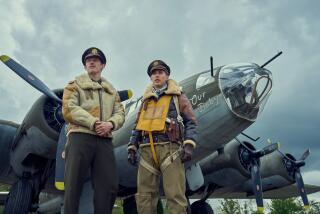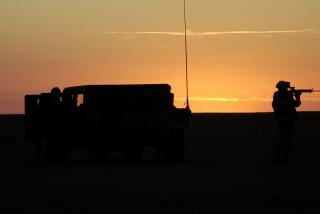Marine Air CO Wings Home From ‘Just War’
- Share via
EL TORO — Maj. Gen. Royal N. Moore Jr., one of the top commanders in the Gulf War, returned home from the Middle East at the command of a sleek fighter jet Thursday and told a crowd of well-wishers that “if there is anything close to a just war, this is probably a just war.”
“I think very simply stated, we went, we saw, we destroyed and we came home,” Moore said after climbing from the cockpit of his gray F/A-18 Hornet. “I had an opportunity to see what Saddam Hussein’s troops did in Kuwait. It is a scene I will never, never forget. . . . (It was a) total rape of that country.”
Moore’s Hornet, accompanied by three others, flew above El Toro Marine Corps Air Station, peeled off and landed at exactly 12:30 p.m., the advertised time of arrival. Moore, 55, along with two dozen Marine pilots in F/A-18s from Hawaii, made the three-day trip from Saudi Arabia to El Toro, with stops in Torrejon, Spain, and Beaufort, N.C.
Moore’s return--along with that of Col. Manfred Rietsch, commander of Marine Air Group 11 from El Toro and Moore’s top F/A-18 pilot--seemed to mark the official end of the war for many in Orange County. Moore controlled 467 aircraft and 16,000 Marines in the Gulf and was part of an elite group of commanders who served under Army Gen. H. Norman Schwarzkopf since the buildup began in August.
F/A-18s, A-6s Intruders and AV-8 Harriers flying under the colors of Moore’s 3rd Marine Aircraft Wing were among the first planes to bomb Iraqi positions in predawn Jan. 17 attacks that marked the beginning of the war.
Helicopters under his command led the ground attack in late February, when Marines from the 1st and 2nd divisions crossed the Kuwaiti border on their way to Kuwait city.
Moore was quick to praise those who “had to stay home” during the conflict.
“Your support, your love, was just unreal,” he said. “We could not have done it without you. You were our inspiration, we owe you a great debt and we are going to try to repay you someday.”
Many of the Marines from the El Toro and Tustin Marine air stations have already returned home, but Moore said 6,000 Marine aviators and their crews remain in the Gulf and will remain there until a truce is signed.
The total losses from the 3rd Aircraft wing included two OV-10 Broncos, an observation plane, and four AV-8 Harriers, an attack jet that has the ability to take off on short runways and land vertically. Although no helicopters were downed in combat, Moore said, three copters--an AH-1W Cobra, a CH-46 Sea Knight and a Vietnam-era UH-1 Huey--were lost in training or during administrative use.
“Discipline” was the answer he gave when asked why the losses were so low.
“We practice and rehearsed. . . . The pilots stayed with that discipline and brought home the bacon,” he said.
When the ground war started, Marine pilots flew low into hostile fire to take out tanks and artillery that threatened advancing troops, Moore said.
Marine aviators flew more close air support the day the ground war started than any other service, he said, adding: “I think that is something to be said about the way we do business.”
He said “clear and simple,” the job of the aircraft wing was to make sure that ground Marines got to Kuwait city.
“We did that . . . in great style and kept the losses down,” he said. “We faced approximately 11 divisions up there at the outset, and by the time 38 days went by and we got to the four days of ground combat, we had them whittled down to a size that those two Marine divisions could take them on.”
Dressed in a camouflaged flight suit, Moore--who served two tours of duty as a Marine fighter pilot in Vietnam, where he flew 287 combat missions--embraced his wife, Patricia, who met him as the plane halted on the Tarmac.
The band played the Marine hymn, and 200 Marines stood at attention. Friends and family members, dressed both in uniform and civilian clothes, stood behind the ropes, waiting for Moore to make his comments.
Moore left for the Gulf in August, shortly after the Iraqi invasion of Kuwait.
Talking to enemy prisoners seemed to tell the story, said Moore, who told of “a fairly high-ranking officer” who “pointed to the sky and said, ‘Too much, too much, too much.’ ”
Moore said another Iraqi regimental artillery officer who was captured said allied forces had not killed that many people, “but you destroyed everything I had on the ground, to include my jeep. When you got my jeep, I knew I was in over my head.”
“That was an indication that we were doing some damage,” Moore said. “We stayed on those targets. We didn’t jump around the battlefield. When we found something out there, we hammered it until it was dead on the battlefield. . . . That philosophy paid off.”
After a few days of vacation at Big Bear, Moore said he will go to work “paying back” the debts he owes. He said he plans to visit the many schools where children wrote letters to Marines in his command.
They are going to hear it from the top, he said.
In conclusion, Moore said, his return from war this time was much different from his return from Vietnam: “You have paid us back far in excess of anything we could ever want. There’s only one word. We really appreciate it.”
MAJ. GEN. ROYAL N. MOORE JR.
Age: 54.
Assignment: Marine Corps Air Station El Toro. Commanding general of 3rd Aircraft Wing with air stations in El Toro, Tustin, Camp Pendleton and Yuma, Ariz.
Aircraft: During the Gulf War, he was commander of all 467 Marine Corps jet fighters and helicopters sent to the Persian Gulf.
Personnel: He was commander of 16,000 Marine fliers, crew members and support personnel in the Persian Gulf. Eight thousand of those men and women were from El Toro and Tustin Marine Corps air stations.
Air war: F/A-18 Hornets, A-6 Intruders and AV-8 Harriers under his command were among the first planes to drop bombs on Iraqi positions when fighting began with a predawn attack Jan. 17.
Ground war: Cobra helicopter gunships under his command cleared the way and then provided air support as the 1st and 2nd Marine infantry divisions crossed into Kuwait on Feb. 24 on their way to Kuwait city.
More to Read
Get the L.A. Times Politics newsletter
Deeply reported insights into legislation, politics and policy from Sacramento, Washington and beyond. In your inbox twice per week.
You may occasionally receive promotional content from the Los Angeles Times.










